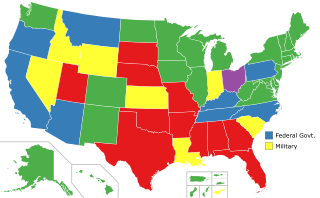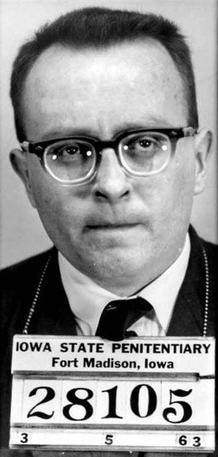Capital punishment, also known as the death penalty and formerly called judicial homicide, is the state-sanctioned practice of killing a person as a punishment for a crime, usually following an authorised, rule-governed process to conclude that the person is responsible for violating norms that warrant said punishment. The sentence ordering that an offender be punished in such a manner is known as a death sentence, and the act of carrying out the sentence is known as an execution. A prisoner who has been sentenced to death and awaits execution is condemned and is commonly referred to as being "on death row". Etymologically, the term capital refers to execution by beheading, but executions are carried out by many methods, including hanging, shooting, lethal injection, stoning, electrocution, and gassing.

In the United States, capital punishment is a legal penalty throughout the country at the federal level, in 27 states, and in American Samoa. It is also a legal penalty for some military offenses. Capital punishment has been abolished in 23 states and in the federal capital, Washington, D.C. It is usually applied for only the most serious crimes, such as aggravated murder. Although it is a legal penalty in 27 states, 20 states currently have the ability to execute death sentences, with the other seven, as well as the federal government, being subject to different types of moratoriums.

Capital punishment is a legal punishment under the criminal justice system of the United States federal government. It is the most serious punishment that could be imposed under federal law. The serious crimes that warrant this punishment include treason, espionage, murder, large-scale drug trafficking, or attempted murder of a witness, juror, or court officer in certain cases.

Victor Harry Feguer was a convicted murderer, and the last federal inmate executed in the United States before the moratorium on the death penalty following Furman v. Georgia, as well as the last person put to death in the state of Iowa. While the media did not pay much attention to Feguer or his execution at the time, Timothy McVeigh's execution sparked renewed media interest in him.

Anthony Chebatoris was a Russian-born bank robber and convicted murderer who is the only person to be executed in the U.S. state of Michigan since it gained statehood in 1837. Although Michigan abolished capital punishment for murder in 1847, Chebatoris was tried under the new Federal Bank Robbery Act of 1934, which made bank robbery and its related offenses federal crimes, beyond state jurisdiction.

Capital punishment is forbidden by the Charter of Fundamental Rights and Freedoms of the Czech Republic and is simultaneously prohibited by international legal obligations arising from the Czech Republic's membership of both the Council of Europe and the European Union.

Capital punishment in Finland has been abolished de jure.
Capital punishment is forbidden in Switzerland under article 10, paragraph 1 of the Swiss Federal Constitution. Capital punishment was abolished from federal criminal law in 1942, but remained available in military criminal law until 1992. The last actual executions in Switzerland took place during World War II.
Capital punishment in the state of Vermont ended in 1972 for all crimes due to Furman v. Georgia and has not been reinstated since. Vermont still has pre-Furman capital statutes on the books but these have been left unenforceable due to Furman. Most states changed their capital punishment laws to conform with Furman and Gregg v. Georgia, but the Vermont legislature has yet to do so, effectively abolishing the death penalty in the state. The state last executed a prisoner, Donald DeMag, in 1954, after he received the sentence for a double robbery-murder he committed after escaping prison.
Capital punishment for juveniles in the United States existed until March 2, 2005, when the U.S. Supreme Court ruled it unconstitutional in Roper v. Simmons. Prior to Roper, there were 71 people on death row in the United States for crimes committed as juveniles.
Capital punishment has been abolished in the U.S. state of Maine since 1887.
Capital punishment was abolished in the U.S. state of North Dakota in 1973. Historically, a total of eight people have been executed in North Dakota, including one execution prior to North Dakota attaining statehood.
Capital punishment is a legal penalty in the United Arab Emirates.
Marvin Charles Gabrion is an American murderer, rapist, and suspected serial killer convicted of the 1997 kidnapping and murder of 19-year-old Rachel Timmerman, of Cedar Springs, Michigan. Timmerman and her 11-month-old daughter, Shannon, disappeared two days before Gabrion was set to stand trial on rape charges filed by Rachel the previous summer. Rachel's body was found in Oxford Lake, weighted down by cinder blocks. Shannon remains missing, but is presumed deceased. Although Gabrion was not tried for killing Shannon, court documents describe her murder as “virtually undisputed.”
Capital punishment is a legal penalty in the U.S. state of Georgia. Georgia reintroduced the death penalty in 1973 after Furman v. Georgia ruled all states' death penalty statutes unconstitutional. The first execution to take place afterwards occurred in 1983.
Ann Wyley was an enslaved woman hanged for burglary in Detroit, at the time part of the British Province of Quebec. She is the only black person and one of the only two women known to have been legally executed in Michigan, and the only woman whose identity is known.
Capital punishment has been abolished in Iowa since 1965. Forty-five men were executed by hanging in Iowa between 1834 and 1963 for crimes including murder, rape, and robbery.
Capital punishment has never been practiced Alaska throughout its history as a state, as it was abolished in 1957. Between December 28, 1869, and April 14, 1950, between the Department, District, and Territory of Alaska, twelve felons, all male, were executed by hanging for murder, robbery, and other crimes. Some were European, some were Native American, and two were African. The territorial legislature abolished capital punishment in 1957 during preparations for statehood, making Alaska the first in the West Coast of the United States to outlaw executions, along with Hawaii, which did the same.





